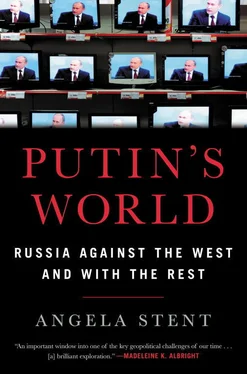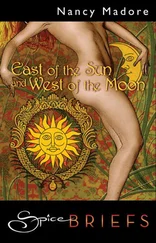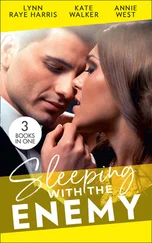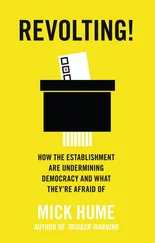A wary Armenian official of the Eurasian Economic Union pithily summed up the current reality: “This independence thing has not worked out that well.” 65Putin does not wish to restore the USSR, but he will continue to seek to exploit the vulnerabilities of his neighboring states as they struggle to move beyond the post-Soviet syndrome, knowing that the West’s response will be restrained.
 7
7 
“THE PAST IS ALWAYS CHANGING”
Russia and Ukraine
Imagine Crimea is yours and the wart on your nose is no more…. This deed will win you immortal glory greater than any Russian Sovereign. Crimea assures dominance of the Black Sea…. Russia needs paradise!
—Prince Grigory Potemkin in correspondence with Empress Catherine the Great 1
Two competing banknotes begin to tell the story. The Russian thousand-ruble note has a picture of Yaroslav the Wise (978–1054), Grand Prince of Kiev, a venerated ruler of Kievan Rus. His father, Vladimir (Volodymyr in Ukrainian), was baptized as an Orthodox Christian in Crimea and accepted Christianity as the religion of Rus. Yaroslav stands sideways with his full beard in the tradition of Muscovite rulers, holding a scepter. The Ukrainian two-hryvna note also has a picture of Yaroslav the Wise. This Yaroslav’s face—with a Ukrainian Cossack-style mustache but no beard—looks straight ahead with no adornments. Both Russia and Ukraine claim Yaroslav as their sovereign, the first to give them a code of law. Was Yaroslav a Russian or a Ukrainian ruler? Was Kievan Rus indeed the origin of the Russian state, as many historians have argued, or was it the cradle of the original Ukrainian nation? For centuries, both Russians and Ukrainians have claimed him as their own. Indeed, the competition for Yaroslav has been so fierce that in 1943, with the Soviet army advancing, Ukrainian clergy removed his remains from the cathedral in Kyiv where he is buried and allegedly moved them to New York, to prevent them from being taken to Moscow. 2
Vladimir Putin does not accept that Russia and Ukraine are two different nations. As he told the documentary filmmaker Oliver Stone, “I’m deeply convinced that the Ukrainian people and the Russian people are not simply close relatives. They are almost the same.” 3Moreover, he does not believe that Ukraine is really a separate state, as he told George W. Bush in 2008.
These are hardly just debates about history. The dueling narratives have, in the past few years, become deadly. As a result of Russia’s annexation of Crimea and support for an ongoing conflict in the Donbas region in Southeastern Ukraine, more than ten thousand people have died, more than two million have become refugees and displaced persons, and Ukraine’s statehood has been under constant pressure. The events of 2014 were a turning point, precipitating a breakdown of the post–Cold War consensus that accepted the borders of the former Soviet republics as the borders of the newly independent states. They have caused many Europeans to question Russia’s commitment to a stable, secure Europe. The Kremlin views Ukraine’s international orientation as an existential question. It claims that if Ukraine were to join the West, this would represent a direct threat to Russia’s heartland. Ukraine in turn views Russia as an existential threat to its continued sovereignty and existence. So far, no resolution to this conflict is in sight. Indeed, Russia’s recent actions have helped unify what was until recently a Ukrainian identity divided between East and West. Why has Russia essentially refused to accept Ukraine’s right to self-determination since the Soviet collapse? What is the Kremlin’s game plan for dealing with Ukraine going forward? Can Russia and Ukraine ever find a peaceful modus vivendi?
THE SHADOW OF KIEVAN RUS
As the old Soviet joke put it, in a system where interpretations of history are protean, “the past is always changing.” In the case of Russia and Ukraine the past has noticeably changed since the Soviet collapse. Moreover, the argument about identity is not only between Russians and Ukrainians but among Ukrainians themselves. Russian and Ukrainian historians have long been engaged in “a struggle for the exclusive possession of the supposed legacy of Kievan Rus.” 4Where did the words “Rus” and “Ukraine” originate? The word “Rus” has Scandinavian roots and was first used to describe Vikings who populated Eastern Europe. A Kievan chronicler first used the word “Ukraine” around 1187 to describe the steppe borderland from Pereiaslav in the east to Galicia in the west. The word “Ukraine” means “borderland,” but it soon fell into disuse as a term for a specific territory and was not revived until the early nineteenth century. We know that Kievan Rus was a polity inhabited by different tribes, among them Eastern Slavs, whose center was in Kyiv, and it encompassed part of today’s Western Russia and Ukraine. It was not a state in the modern sense of the word and had no centralized government. 5It came into being sometime in the mid-tenth century and ended on December 7, 1240, when the invading Mongols took Kyiv. Indeed, the battle of historical accounts continues with different narratives about life under the Mongols. Russians talk about the “Tatar yoke” and Mongol oppression; Ukrainians portray them as less intrusive. 6
After the Mongols retreated, today’s Ukraine became part of the Polish-Lithuanian Commonwealth and remained under its rule until 1648. The commonwealth was a multinational state, and its population fluctuated with waves of different migrations, including those of the Ukrainian Cossacks. A French military engineer who served in the Polish army described these freebooters in 1651 in vivid terms:
There is not one of them, of any age, sex or rank whatever, who does not try to drink more than his companion, and to outdo him in revelry…. They are sly, crafty, clever [and yet] sincerely generous… they greatly value their liberty, and would not want to live without it. 7
THE FIRST INDEPENDENCE INTERLUDE
It was a Cossack who first led Ukrainians to independence from the Poles—only to change course and unite Ukrainian lands with Russia. Cossack nobleman officer Bohdan Khmelnytsky led the revolt against the Poles and, to his surprise, defeated their armies. Khmelnytsky arranged a triumphant entrance into Kyiv in December 1648, where he was hailed as the new leader of Rus and called “Moses” for delivering the nation from Polish enslavement. 8But the revolt soon became internationalized, and Khmelnytsky eventually decided to seek a new protector. In 1654, in the town of Pereiaslav, a group of Cossack officers and their leader swore allegiance to the new sovereign of Ukraine, Tsar Aleksei Romanov of Muscovy, the second Romanov tsar. (In 2017, when the separatists in Southeastern Ukraine declared their own independent state, they did so with a replica of Khmelnytsky’s banner. 9) So ended the first, brief period of Ukrainian independence and began the long, complex relationship with Russia. In 1954, the USSR with great fanfare celebrated the tercentennial of Ukraine’s “reunification” with Russia. The reality is a little more prosaic. The tsar, unlike the Polish king, was willing to grant the Cossacks privileged status and recognize their statehood. Hence Khmelnytsky’s decision to align with Muscovy. What is striking in the complex Russia-Ukraine relationship is the constant inveighing of competing historical narratives.
UKRAINIANS IN THE RUSSIAN AND AUSTRO-HUNGARIAN EMPIRES
Between the late eighteenth century and 1917, people who came to identify themselves as Ukrainians lived in both the Russian and Austro-Hungarian empires. This split historical experience is the basis for Putin’s claim to Bush that part of Ukraine is in Eastern Europe while most of it “was given” to Russia. It also explains why the formation of a unified Ukrainian national identity has been such a challenge since independence and why some Ukrainian citizens in the east of the country feel more affinity with Russia than with Ukraine.
Читать дальше

 7
7 










